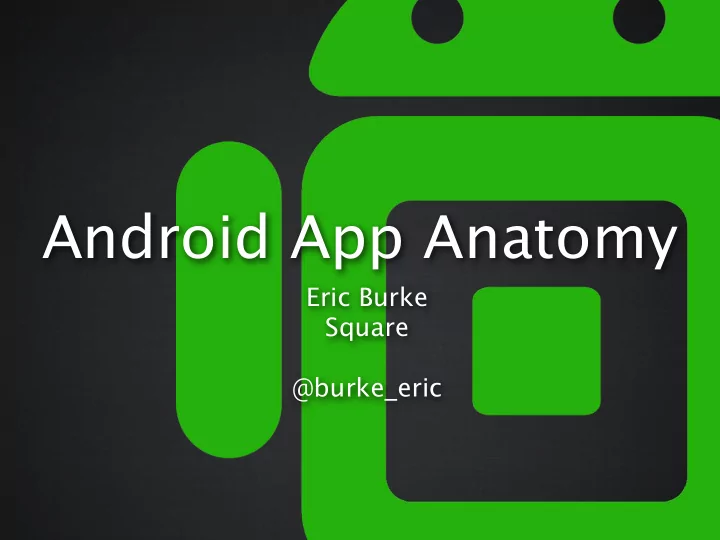

Android App Anatomy Eric Burke Square @burke_eric
Topics • Android lifecycle • Fragments • Open source • Tape • Otto • Dagger
ActionBarSherlock Android Design on every device.
Lifecycle
Install Apps Run Forever Uninstall
Process 1 Process 2 Apps Run Forever
Activity Activity Activity Process 1 Process 2 Apps Run Forever
R.I.P . Static Variables Activity Activity Activity Process 1 Process 2 Apps Run Forever
Kill your process
Tape
“If you respect users, persist tasks to disk.” - Jesse Wilson
Don’t Do This
Server Loader or Client UI Thread Image File
Do This Pending
Tape API • QueueFile • O(1) FIFO queue of byte[] • ObjectQueue • A queue of <T> • TaskQueue • Injects and starts tasks
Tape Server Client UI TaskQueue peek() remove() add() Service UploadTask UploadTask
Usage Pattern 1. UI adds to a TaskQueue: queue.add(new ImageUploadTask(image)); 2. Start the Android Service: context.startService(new Intent(context, ImageUploadTaskService.class));
3. Service executes the next task: Task t = queue.peek(); t.execute(this); // Listener 4. If successful: queue.remove(); executeNext(); 5. If failure, schedule a retry.
Retrying Failed Tasks • Always process tasks in order: FIFO • Distinguish between client bugs vs. network or server exceptions • Client errors - do not retry • Server & network errors - retry
Fragment Lifecycle
onCreate() onSaveInstanceState() Activity Time ➞
Tap the Upload Button Activity Time ➞
Loader or Thread Activity Time ➞
DialogFragment beginTransaction() Loader or Thread Activity Time ➞
DialogFragment commit() Loader or Thread Activity onSaveInstanceState() Time ➞
Square does not* use Loaders.
Fragment Layout
Advantages • Smooth animations between steps • ActionBar does not move • Code organization
Onboarding Fragment Fragment Fragment Payment Flow Settings Fragment Fragment Fragment Fragment Fragment Fragment
Fragment → Activity Communication implements Containing Activity defines Listener Fragment Interface http://developer.android.com/training/basics/fragments/communicating.html
Listener Interface public class NewsFragment extends Fragment { private Listener listener; public interface Listener { void onItemSelected(int position); } @Override public void onAttach(Activity a) { super.onAttach(a); listener = (Listener) a; } }
Activity public class HomeActivity extends Activity implements NewsFragment.Listener { @Override public void onItemSelected(int position) { … } }
public class Onboarding extends Activity implements AccountFragment.Listener, ActivateFragment.Listener, ShippingFragment.Listener, BankFragment.Listener, etc... { // The god object... }
Fragment Fragment Fragment Activity Fragment Fragment Fragment How can Fragments communicate without tight Activity coupling?
Publish Subscribe Fragment Fragment Bus Fragment Fragment Service Activity
LocalBroadcastManager • Included in Android Support library • Publishes Intents within your process
Publishing Intent intent = new Intent( BroadcastIds.LOCATION_UPDATED_ACTION); intent.putExtra( BroadcastIds.CURRENT_LOCATION_KEY, getCurrentLocation()); LocalBroadcastManager.getInstance( getActivity()).sendBroadcast(intent);
Publishing Intent intent = new Intent( BroadcastIds.LOCATION_UPDATED_ACTION); intent.putExtra( BroadcastIds.CURRENT_LOCATION_KEY, getCurrentLocation()); LocalBroadcastManager.getInstance( getActivity()).sendBroadcast(intent);
Publishing Intent intent = new Intent( BroadcastIds.LOCATION_UPDATED_ACTION); intent.putExtra( BroadcastIds.CURRENT_LOCATION_KEY, getCurrentLocation()); LocalBroadcastManager.getInstance( getActivity()).sendBroadcast(intent);
Subscribing BroadcastReceiver receiver = new BroadcastReceiver() { @Override public void onReceive( Context context, Intent intent) { Location location = (Location) intent.getParcelableExtra( BroadcastIds.CURRENT_LOCATION_KEY); showLocation(location); } };
Subscribing IntentFilter locationFilter = new IntentFilter( BroadcastIds.LOCATION_UPDATED_ACTION); @Override public void onResume() { super.onResume(); LocalBroadcastManager.getInstance(getActivity()) .registerReceiver(receiver, locationFilter); } @Override public void onPause() { super.onPause(); LocalBroadcastManager.getInstance(getActivity()) .unregisterReceiver(receiver); }
Boilerplate. No type safety. Hard to test.
Otto
Registration public class BaseFragment extends Fragment { @Inject Bus bus; @Override public void onResume() { super.onResume(); bus.register(this); } @Override public void onPause() { super.onPause(); bus.unregister(this); } }
Registration public class BaseFragment extends Fragment { @Inject Bus bus; @Override public void onResume() { super.onResume(); bus.register(this); } @Override public void onPause() { super.onPause(); bus.unregister(this); Fails fast at } } runtime.
Subscribing @Subscribe public void onLocationUpdated(Location l) { showLocation(l); } Receives any type extending Location.
Publishing bus.post (getCurrentLocation()); Synchronous delivery.
@Produce (getting data the first time)
How to get this image?
post(UserImage) Downloader Bus UserImageCache
Subscribing public class AccountActivity extends BaseActivity { @Subscribe public void onUserImageUpdated( UserImage image ) { ((ImageView) findViewById(R.id.image)) .setImageBitmap(image.getBitmap()); }
get() done() onResume() onPause() Downloader Activity UserImageCache
Producers @Singleton public class UserImageCache { @Produce public UserImage produceUserImage() { return cachedUserImage; } … }
Activity @Subscribe Bus @Produce UserImageCache
@Produce decouples threads from the Activity and Fragment lifecycle.
Otto API Summary • register(), unregister(), post() • @Subscribe, @Produce • Thread confinement • Easy to test!
Origins of Otto • Forked from Guava’s EventBus • Optimized for Android - 16k! • Less reflection; more caching
Dependency Injection
Guice on Android? • We’ve used it for 2+ years • Startup performance is a challenge • Runtime error checking • See also: RoboGuice
Can we do better?
Dagger †
† What is Dagger? Compile-time dependency injection.
† @Inject import javax.inject.Inject; // JSR-330 public class PublishFragment extends BaseFragment { @Inject Bus bus; @Inject LocationManager locationManager; … }
† Constructor Injection public class AccountUpdater { private final Bus bus; private final AccountService accounts; @Inject public AccountUpdater (Bus bus, AccountService accounts) { this.bus = bus; this.accounts = accounts; } }
† Module @Module( entryPoints = { HomeActivity.class, PublishFragment.class, SubscribeFragment.class } ) public class ExampleModule { @Provides @Singleton Bus provideBus() { return new Bus(); } }
† Module @Module( entryPoints = { HomeActivity.class, PublishFragment.class, SubscribeFragment.class } ) public class ExampleModule { @Provides @Singleton Bus provideBus() { return new Bus(); } }
† Missing Provider Method? No injectable members on com.squareup.otto.Bus. Do you want to add an injectable constructor? required by com.squareup.anatomy.PublishFragment for com.squareup.anatomy.ExampleModule
† Bootstrapping public class ExampleApp extends Application { private ObjectGraph objectGraph; @Override public void onCreate() { super.onCreate(); objectGraph = ObjectGraph.get( new ExampleModule(this)); } public ObjectGraph objectGraph() { return objectGraph; } }
† Bootstrapping public class ExampleApp extends Application { private ObjectGraph objectGraph; @Override public void onCreate() { super.onCreate(); objectGraph = ObjectGraph.get( new ExampleModule(this)); } public ObjectGraph objectGraph() { return objectGraph; } }
† Bootstrapping public class ExampleApp extends Application { private ObjectGraph objectGraph; @Override public void onCreate() { super.onCreate(); objectGraph = ObjectGraph.get( new ExampleModule(this)); } public ObjectGraph objectGraph() { return objectGraph; } }
† Bootstrapping public class ExampleApp extends Application { private ObjectGraph objectGraph; @Override public void onCreate() { super.onCreate(); objectGraph = ObjectGraph.get( new ExampleModule(this)); } public ObjectGraph objectGraph() { return objectGraph; } }
† Fragment ExampleApp (ObjectGraph) BaseFragment NameFragment AddressFragment
Recommend
More recommend